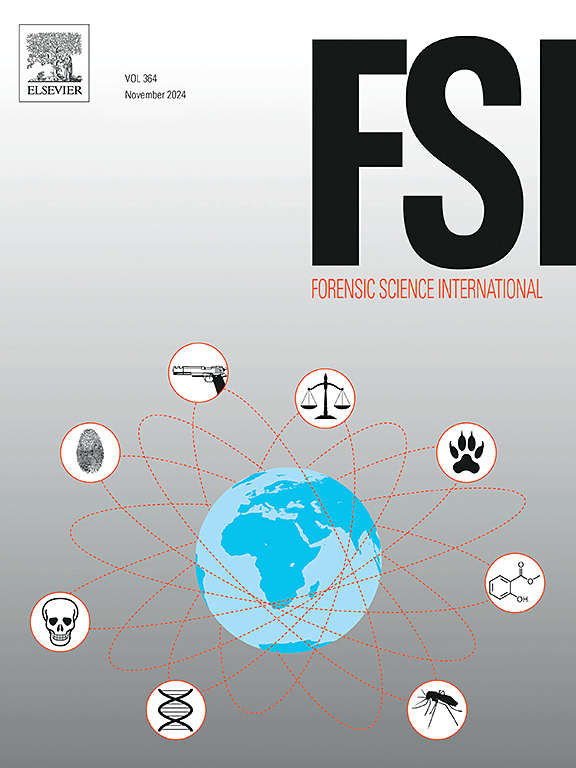Investigation of iron oxide powders for use in powder suspension formulations in fingermark development
IF 2.2
3区 医学
Q1 MEDICINE, LEGAL
引用次数: 0
Abstract
A powder suspension (PS) is a fine powder dispersed through a detergent and water solution. It is typically used for treating latent fingermarks on both wetted and dry adhesive, semi or nonporous surfaces. Iron oxide powder suspensions (FePS) are recommended on light non-porous surfaces and adhesive surfaces but is not commercially available. This type of PS is therefore more customisable as different iron oxide powders can be used on a range of surface types. This overall aim was to examine a variety of different iron oxide powders and investigate the impact that variations can have on fingermark development with FePS. This research was divided into two stages to understand the general performance of the iron oxide component in FePS. The first stage of this research examined the iron oxide powder in both its dry form and as a powder suspension. This stage found all iron oxide powders were more effective when applied as a suspension rather than its dry powder form. Microscopically, a clear difference between the powder selectivity of both techniques was visually observed, with the FePS technique producing more selective powder deposition than the dry powder. The optimised FePS formulation from stage 1 was then compared to the current recommended formulation in stage 2. A red iron (III) oxide PS, which has not been previously examined in literature had the best overall results in both stages and was shown to have an increased percentage of identifiable mark quality on all examined substrates, outperforming both old and new recommended FePS powders when mixed with 10 % Tween 20 surfactant. However, the recommended nano FePS was more suitable for the adhesive tape surface due to the iron (III) oxide PS having strong background development. The use of suspensions on wetted fingermarks was also examined in stage 2 and was found to not have a great impact on fingermark quality on the glass and plastic surfaces, and all formulations successfully developed fingermarks up to 1 month old. From these findings it can be stated that the type of iron oxide powder greatly influences the quality of marks that are produced with FePS. Hence, different iron oxide powders for PS do require a closer examination under the new surfactant formulation recommended.
手印显影用粉末悬浮剂氧化铁粉的研究
粉末悬浮液(PS)是一种通过洗涤剂和水溶液分散的细粉末。它通常用于处理湿的和干的粘合剂,半或非多孔表面上的潜在手印。氧化铁粉末悬浮液(FePS)推荐用于较轻的无孔表面和粘附表面,但不是市售的。由于不同的氧化铁粉末可用于一系列表面类型,因此这种类型的PS更具可定制性。这一总体目标是检查各种不同的氧化铁粉末,并研究变化可能对FePS手印发展的影响。本研究分为两个阶段,以了解FePS中氧化铁组分的一般性能。本研究的第一阶段检查了氧化铁粉末的干燥形式和粉末悬浮液。这个阶段发现所有的氧化铁粉末作为悬浮液而不是干粉形式应用时更有效。在显微镜下,两种技术的粉末选择性明显不同,FePS技术产生的粉末沉积比干粉更有选择性。然后将第一阶段的优化FePS配方与第二阶段的当前推荐配方进行比较。一种红色铁(III)氧化物PS,在之前的文献中没有被研究过,在两个阶段都有最好的总体结果,并且在所有被检查的基材上具有更高的可识别标记质量百分比,当与10 % Tween 20表面活性剂混合时,其性能优于旧的和新的推荐FePS粉末。然而,由于氧化铁(III) PS具有很强的背景显影性,因此推荐的纳米FePS更适合于胶带表面。在第二阶段,我们也对湿手印使用悬浮液进行了研究,发现对玻璃和塑料表面的手印质量没有太大影响,所有配方都成功地开发了长达1个月的手印。从这些发现可以看出,氧化铁粉末的类型对FePS产生的标记质量有很大影响。因此,在推荐的新表面活性剂配方下,PS用不同的氧化铁粉末确实需要更仔细的检查。
本文章由计算机程序翻译,如有差异,请以英文原文为准。
求助全文
约1分钟内获得全文
求助全文
来源期刊

Forensic science international
医学-医学:法
CiteScore
5.00
自引率
9.10%
发文量
285
审稿时长
49 days
期刊介绍:
Forensic Science International is the flagship journal in the prestigious Forensic Science International family, publishing the most innovative, cutting-edge, and influential contributions across the forensic sciences. Fields include: forensic pathology and histochemistry, chemistry, biochemistry and toxicology, biology, serology, odontology, psychiatry, anthropology, digital forensics, the physical sciences, firearms, and document examination, as well as investigations of value to public health in its broadest sense, and the important marginal area where science and medicine interact with the law.
The journal publishes:
Case Reports
Commentaries
Letters to the Editor
Original Research Papers (Regular Papers)
Rapid Communications
Review Articles
Technical Notes.
 求助内容:
求助内容: 应助结果提醒方式:
应助结果提醒方式:


